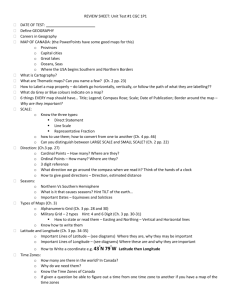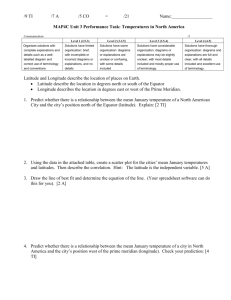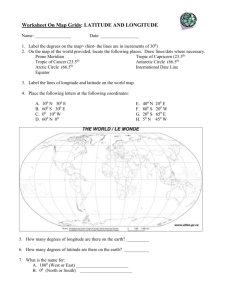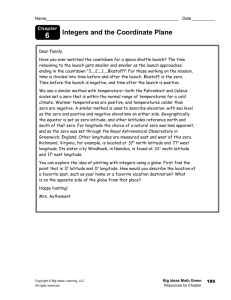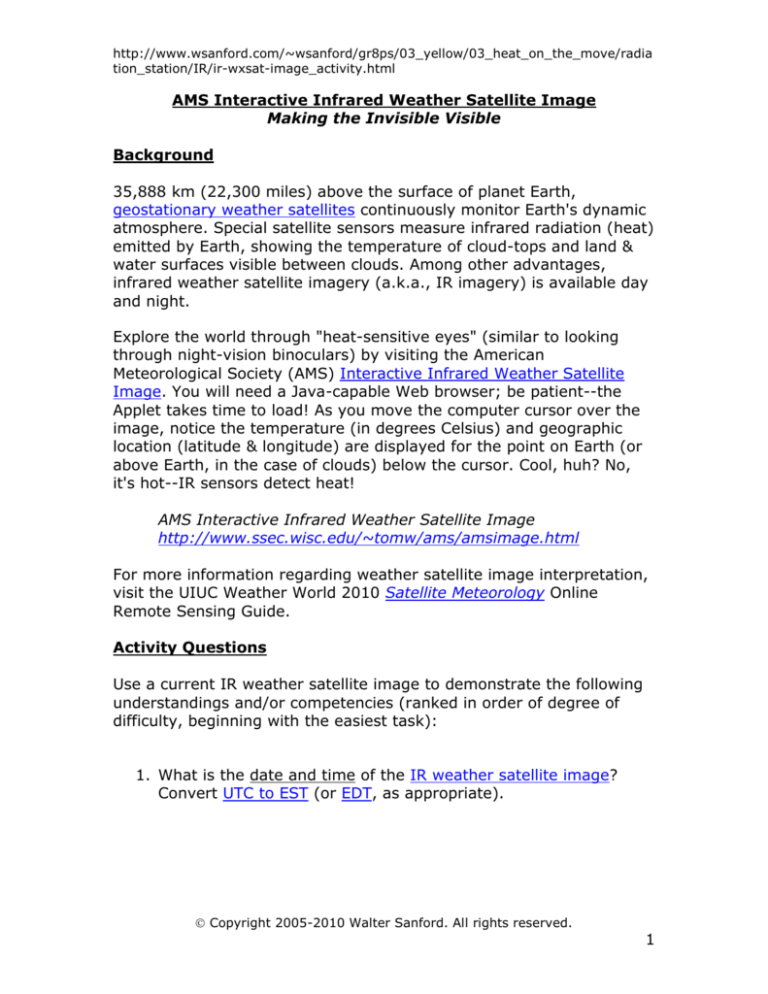
http://www.wsanford.com/~wsanford/gr8ps/03_yellow/03_heat_on_the_move/radia
tion_station/IR/ir-wxsat-image_activity.html
AMS Interactive Infrared Weather Satellite Image
Making the Invisible Visible
Background
35,888 km (22,300 miles) above the surface of planet Earth,
geostationary weather satellites continuously monitor Earth's dynamic
atmosphere. Special satellite sensors measure infrared radiation (heat)
emitted by Earth, showing the temperature of cloud-tops and land &
water surfaces visible between clouds. Among other advantages,
infrared weather satellite imagery (a.k.a., IR imagery) is available day
and night.
Explore the world through "heat-sensitive eyes" (similar to looking
through night-vision binoculars) by visiting the American
Meteorological Society (AMS) Interactive Infrared Weather Satellite
Image. You will need a Java-capable Web browser; be patient--the
Applet takes time to load! As you move the computer cursor over the
image, notice the temperature (in degrees Celsius) and geographic
location (latitude & longitude) are displayed for the point on Earth (or
above Earth, in the case of clouds) below the cursor. Cool, huh? No,
it's hot--IR sensors detect heat!
AMS Interactive Infrared Weather Satellite Image
http://www.ssec.wisc.edu/~tomw/ams/amsimage.html
For more information regarding weather satellite image interpretation,
visit the UIUC Weather World 2010 Satellite Meteorology Online
Remote Sensing Guide.
Activity Questions
Use a current IR weather satellite image to demonstrate the following
understandings and/or competencies (ranked in order of degree of
difficulty, beginning with the easiest task):
1. What is the date and time of the IR weather satellite image?
Convert UTC to EST (or EDT, as appropriate).
Copyright 2005-2010 Walter Sanford. All rights reserved.
1
http://www.wsanford.com/~wsanford/gr8ps/03_yellow/03_heat_on_the_move/radia
tion_station/IR/ir-wxsat-image_activity.html
2. Given the latitude & longitude of Washington, D.C. (39°N,
77°W), find its location on the IR weather satellite image. Record
the current temperature (either land or cloud-top) in the vicinity
of Washington, D.C. Convert the temperature from degrees
Celsius to degrees Fahrenheit and kelvins.
3. State the relationship between color (black, white, and shades of
gray) and temperature, as shown on the IR weather satellite
image.
4. Use geographic coordinates (latitude/longitude) to identify the
location of an example of each of the following types of physical
features shown on the IR weather satellite image:
A. land surfaces:
[Hint: In order to clearly distinguish land- and water surfaces from
low-level clouds, it may be helpful to compare & contrast the IR
weather satellite image with the latest visible image (similar to a
black & white photograph of Earth).]
B.
water surfaces:
[Hint: See hint, No. 4-A (above).]
C. cloud-tops, including both high- and low cloud-tops:
[Hint: The temperature of the atmosphere usually decreases with
increasing altitude.]
5. Compare and contrast temperatures of different surfaces shown
on the IR weather satellite image; explain possible causes for
the observed temperature difference (if any). Use geographic
coordinates (latitude/longitude) to identify the locations used for
comparison.
[Hint: In order to "ground-truth" (verify) satellite-derived land surface
temperatures, refer to a current weather map showing surface temperatures.
See also: a map of available surface stations, showing the three-letter
location identifier (LOCID) for each station; a list of LOCIDs (by state),
Copyright 2005-2010 Walter Sanford. All rights reserved.
2
http://www.wsanford.com/~wsanford/gr8ps/03_yellow/03_heat_on_the_move/radia
tion_station/IR/ir-wxsat-image_activity.html
including the name and location (latitude/longitude) of each surface station.
See question No. 7 (below) for guidance regarding ground-truthing sea
surface temperatures (SSTs).]
A. land and water temperatures at the same latitude:
B. land surface temperatures at different latitudes:
In general, what is the relationship between surface temperature
and latitude on Earth?
As latitude increases, surface temperature...
6. For some storms, especially convective storms such as
thunderstorms, there is an association between storm intensity
and the height of storm cloud-tops: more intense weather is
often--but not always--associated with higher, colder cloud-tops.
A. Infer the location of the most intense storms by
searching for places on the IR weather satellite image
displaying the coldest cloud-top temperatures: use
geographic coordinates (latitude/longitude) to identify
these locations; record the cloud-top temperature at
each location.
B. Verify your inference that intense weather is occuring at
these locations by accessing other online sources of
real-time weather observations. Cite references that
support your inferences, e.g., heavy- to severe
precipitation shown by a national RADAR summary (a
composite image of data collected from a national
network of local weather RADARs), or heavy
precipitation (including thunderstorms) reported by a
National Weather Service (NWS) Forecast Office shown
on a surface map of current weather observations. [See
also: a map of available surface stations, showing the
three-letter location identifier (LOCID) for each station;
Copyright 2005-2010 Walter Sanford. All rights reserved.
3
http://www.wsanford.com/~wsanford/gr8ps/03_yellow/03_heat_on_the_move/radia
tion_station/IR/ir-wxsat-image_activity.html
a list of LOCIDs (by state), including the name and
location (latitude/longitude) of each surface station.]
[Hint: Weather RADARs use microwave radiation to "see"
precipitation-sized particles within- and falling from clouds: the
greater the reflectivity (measured in DBZs), the more intense the
precipitation. For more information regarding weather radar image
interpretation, visit the UIUC Weather World 2010 Radar
Meteorology Online Remote Sensing Guide.]
7. Use an IR weather satellite image to locate ocean surface
currents, e.g., the Gulf Stream (warm) and/or the California
Current (cold). Use geographic coordinates (latitude/longitude)
to identify one or more points located near the boundary of the
ocean currents (where there is a sharp temperature contrast). In
order to verify satellite-derived sea surface temperatures
(SSTs), refer to ocean buoys reporting near-real-time SSTs:
Click on either "Southeast" or "Southwest" USA, as appropriate;
NDBC Moored Buoys (see square blue symbols) report "Water
Temperature" (WTMP). The exact location (latitude/longitude) of
each buoy is provided on its page of "Recent Observations." The
NOAA/NWS NDBC reports surface air and water temperatures in
degrees Fahrenheit; quickly convert these temperatures to
degrees Celsius using the "weather calculator."
[Hint: Sea surface temperature analysis requires a relatively cloud-free view
of the ocean. In order to get a clearer view of the ocean surface, you may
need to refer to computer-generated five-day average composite images of
the appropriate regions of the Atlantic- and Pacific Ocean: select either "U.S.
East Coast" or "U.S. West Coast"; view/browse the images; access the most
recent composite image. Correlate the NOAA POES AVHRR composite image
with the current NOAA GOES IR weather satellite image.]
Copyright 2005-2010 Walter Sanford. All rights reserved.
4


